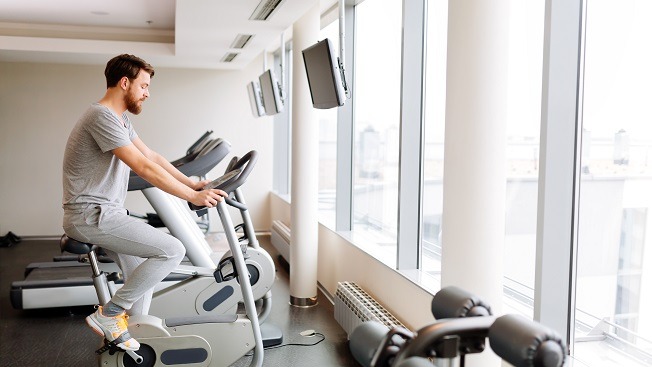If you thought exercising on a bike that actually doesn’t take you anywhere is ineffective, think again. There’s a reason why numerous households have a stationary bicycle. That’s because when ridden the right way, working out on a stationary bike can provide a low-impact, high-intensity cardiovascular exercise building strength, and endurance at the same time.
What to look for when buying a stationary bicycle
To get the most out of riding a stationary bike, the first shop for one smartly. When making this decision, ask yourself, “Will this stationary bicycle help me meet my exercise goals, is it comfortable to ride, and will I use it regularly?”
Here are a few factors to consider:
- Comfort – This is key – a stationary bike that makes you cringe because it causes you discomfort, will soon become a bike collecting dust. A key comfort must is a seat cushion keeping your tush comfy without aches and pains.
- Adjustable seat and handlebars – A good stationary bike should have a seat that adjusts both vertically (up and down) and horizontally (forward and backward). This helps you get into proper positioning once on the bike. The handlebars should be able to be adjusted up and down and forward and backward too. Also, refrain from having the seat too high or too low – it can result in pain in the back of the knee or pain in the front of the knee.
- Stability – Whenever you use your bike, first and foremost it must be safe. Make sure it looks and feels sturdy when you test one out. The bike should not move when you pedal but rather stay firmly on the floor.
- Types of bikes – Stationary bikes of today come in a wide variety of styles – traditional upright bikes, spin bikes, street bike trainers, and recumbent bikes. It’s really a matter of what you prefer but check each out to find the one you like best.
Maintain good posture on your bike
A common reason for those that used a stationary bike but then stopped might have been aches and pains or an injury. Part of those reasons may have been related to poor or incorrect posture when seated and riding the bike. To get the most out of your workout with a stationary bike, here are tips on correct posturing:
- Stay seated on the widest part of the saddle – when you are seated, hinge forward at the hips to reach the handlebars, engaging your abdominals doing so. Make sure your knees are lined up with your hips and feet.
- Keep your spine straight – Keep your upper body aligned with a long spine (no slumping) while keeping shoulders relaxed and neutral. When riding, keep elbows slightly bent and close to your body.
- Avoid leaning on the handlebars – This puts undue stress on your wrists and forearms preventing your lower body from doing more work.
- Keep feet flat on the pedals – Avoid pointing toes down when pedaling. This puts pressure on your knees. Instead, drive through each pedal stroke from the ball of your foot. When your feet come up with the upstroke, they should remain flat.
- Hold your head up – Align your head with your neck and spine to prevent neck strain. If you flop your head forward, this can cause lightheadedness or dizziness.
Health benefits of riding a stationary bicycle
Now that you know how to be properly positioned on your stationary bicycle, it’s time to discuss the numerous healthy benefits you will derive from your ride.
- Improved cardiovascular health – This is probably the number one reason why most people want to use a stationary bicycle – it’s good for heart health.
- Weight loss – Regular indoor cycling helps in reducing body weight and burning body fat, even without making dietary changes.
- Knee injury tool – Most doctors will approve the use of a stationary bicycle for individuals with knee strain or an injury. Riding a stationary bicycle helps distribute stress across the quadriceps muscles, calves, core, glutes, and knees preventing the knees taking most of the workload.
- Low-impact workout – For anyone requiring a low-impact exercise or anyone needing a recovery training day, using a stationary bicycle is perfect. It’s also good for bad weather days when being outdoors exercising is not feasible.
- Builds muscle – When using a stationary bike, you’re engaging all major muscle groups from your core, glutes, quadriceps, calves, hamstrings and upper body muscles in the shoulder, back and arms, helping strengthen these muscles over time.
- You’ll stay safer – Anyone riding a bicycle sharing the road with cars and trucks including pedestrians and potholes, is always vulnerable to major bodily injury or death. But, riding a stationary bike indoors is a much safer option. Plus, you won’t have to deal with weather extremes.


